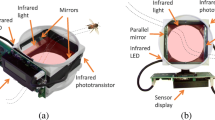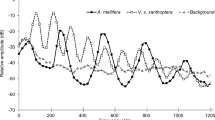Abstract
The ability to use inexpensive, noninvasive sensors to accurately classify flying insects would have significant implications for entomological research, and allow for the development of many useful applications in vector control for both medical and agricultural entomology. Given this, the last sixty years have seen many research efforts on this task. To date, however, none of this research has had a lasting impact. In this work, we explain this lack of progress. We attribute the stagnation on this problem to several factors, including the use of acoustic sensing devices, the overreliance on the single feature of wingbeat frequency, and the attempts to learn complex models with relatively little data. In contrast, we show that pseudo-acoustic optical sensors can produce vastly superior data, that we can exploit additional features, both intrinsic and extrinsic to the insect’s flight behavior, and that a Bayesian classification approach allows us to efficiently learn classification models that are very robust to overfitting. We demonstrate our findings with large scale experiments, as measured both by the number of insects and the number of species considered.







Similar content being viewed by others
Notes
An even earlier paper (Reed et al. 1941) makes a similar suggestion. However, these authors determined the wingbeat frequencies manually, aided by a stroboscope.
A commercially available rotator bottle trap made by BioQuip® (2850) does allow researchers to measure the time of arrival at a granularity of hours. However, as we shall show in Section Additional Feature: Circadian Rhythm of Flight Activity, we can measure the time of arrival at a sub-second granularity and exploit this to improve classification accuracy.
While there is a formal framework to define the complexity of a classification model (i.e. the VC dimension (Vapnik and Chervonenkis 1971)), informally we can think of a complicated or complex model as one that requires many parameters to be set or learned.
Many large insects, i.e. most members of Odonata and/or Lepidoptera, have wingbeat frequencies that are significantly slower than 100 Hz; our choice of truncation level reflects our special interest in Culicidae.
References
Banko M, Brill E (2001) Mitigating the paucity-of-data problem: Exploring the effect of training corpus size on classifier performance for natural language processing. Proceedings of the first international conference on Human language technology research (pp. 1–5). Association for Computational Linguistics
Batista GE, Keogh EJ, Mafra-Neto A, Rowton E (2011) SIGKDD demo: sensors and software to allow computational entomology, an emerging application of data mining. In Proceedings of the 17th ACM SIGKDD international conference on Knowledge discovery and data mining, pp. 761–764
Belton P, Costello RA (1979) Flight sounds of the females of some mosquitoes of Western Canada. Entomologia experimentalis et applicata 26(1):105–114
Benedict M, Robinson A (2003) The first releases of transgenic mosquitoes: an argument for the sterile insect technique. TRENDS in Parasitology 19(8):349–355, Accessed March 8, 2012
Boll S (1979) Suppression of acoustic noise in speech using spectral subtraction. Acoustics, Speech and Signal Processing, IEEE Transactions on,27 (2), 113–120
Capinera, JL (2008). Encyclopedia of entomology. Springer. Epsky ND, Morrill WL, Mankin R (2005) Traps for capturing insects. In Encyclopedia of Entomology, pp. 2319–2329. Springer Netherlands
Chen Y (2013) Supporting Materials https://sites.google.com/site/insectclassification/
Chen Y, Hu B, Keogh E, Batista GE (2013) DTW-D: time series semi-supervised learning from a single example. In Proceedings of the 19th ACM SIGKDD international conference on Knowledge discovery and data mining. pp. 383–391
Chen Y, Why A, Batista G, Mafra-Neto A, Keogh E (2014) supporting technique report http://arxiv.org/abs/1403.2654
Cooperband MF, Hartness A, Lelito JP, Cosse AA (2013) Landing surface color preferences of Spathius agrili (Hymenoptera: Braconidae), a parasitoid of emerald ash borer, Agrilus planipennis (Coleoptera: Buprestidae). J Insect Behav 26(5):721–729
Deakin MA (2010) Formulae for insect wingbeat frequency. Journal of Insect Science,10 (96):1
Devroye L (1996) A probabilistic theory of pattern recognition. Springer Vol 31
Elkan, C (2001) The foundations of cost-sensitive learning. In international joint conference on artificial intelligence, vol. 17, No. 1, pp. 973–978. LAWRENCE ERLBAUM ASSOCIATES LTD.
Ephraim Y, Malah D (1984) Speech enhancement using a minimum-mean square error short-time spectral amplitude estimator. Acoustics, Speech and Signal Processing, IEEE Transactions on 32(6):1109–1121
Frick TB, Tallamy DW (1996) Density and diversity of non-target insects killed by suburban electric insect traps. Entomological News 107:77–82
Fukunaga K (1990) Introduction to statistical pattern recognition. Online via Elsevier, Access
Georghiou GP, Wirth MC (1997) Influence of exposure to single versus multiple toxins of bacillus thuringiensis subsp. israelensis on Development of Resistance in Mosquito Culex quinquefasciatus (Diptera: Culicidae). Appl Environ Microbiol 63(3):1095–1101
Grimaldi RP (1989) Discrete and Combinatoral Mathematics: An Applied Introduction 2nd Ed. Addison-Wesley Longman Publishing Co., Inc
Halevy A, Norvig P, Pereira F (2009) The unreasonable effectiveness of data. IEEE Intell Syst 24(2):8–12
Hao Y, Campana B, Keogh EJ (2012) Monitoring and mining animal sounds in visual space. J Insect Behav 1–28
Kahn MC, Celestin W, Offenhauser W (1945) Recording of sounds produced by certain disease-carrying mosquitoes. Science 101:335–336
Kahn MC, Offenhauser W (1949) The identification of certain West African mosquitos by sound. Amer J trop IVied 29:827–836
Keogh E, Pazzani M (1999) Learning augmented Bayesian classifiers: A comparison of distribution-based and classification-based approaches. In Proceedings of the seventh international workshop on artificial intelligence and statistics. pp. 225–230.
Kohavi R (1995) A study of cross-validation and bootstrap for accuracy estimation and model selection. In IJCAI (Vol. 14, No. 2, pp. 1137–1145
Li Z, Zhou Z, Shen Z, Yao Q (2009) Automated identification of mosquito (diptera: Culicidae) wingbeat waveform by artificial neural network. Artificial Intell Applications and Innovations 187(2009):483–489
Mack YP, Rosenblatt M (1979) Multivariate k-nearest neighbor density estimates. J Multivar Anal 9(1):1–15
Mankin RW, Machan R, Jones R (2006) Field testing of a prototype acoustic device for detection of Mediterranean fruit flies flying into a trap. Proc. 7th Int. Symp. Fruit Flies of Economic Importance, pp. 10–15
Moore A (1991) Artificial neural network trained to identify mosquitoes in flight. J Insect Behav 4(3):391–396
Moore A, Miller RH (2002) Automated identification of optically sensed aphid (Homoptera: Aphidae) wingbeat waveforms. Ann Entomol Soc Am 95:1–8
Moore A, Miller JR, Tabashnik BE, Gage SH (1986) Automated identification of flying insects by analysis of wingbeat frequencies. J Econ Entomol 79:1703–1706
Papathanos PA, Bossin HC, Benedict MQ, Catteruccia F, Malcolm CA, Alphey L, Crisanti A (2009) Sex separation strategies: past experience and new approaches. Malar J 8(Suppl 2)
Prechelt L (1995) A quantitative study of neural network learning algorithm evaluation practices. In proceedings of the 4th Int’l Conference on Artificial Neural Networks. pp. 223–227
Raman DR, Gerhardt RR, Wilkerson JB (2007) Detecting insect flight sounds in the field: Implications for acoustical counting of mosquitoes. Trans ASABE 50(4):1481
Reed SC, Williams CM, Chadwick LE (1942) Frequency of wing-beat as a character for separating species races and geographic varieties of Drosophila. Genetics 27:349–361
Repasky KS, Shaw JA, Scheppele R, Melton C, Carsten JL, Spangler LH (2006) Optical detection of honeybees by use of wing-beat modulation of scattered laser light for locating explosives and land mines. Appl Opt 45:1839–1843
Rund SSC, Lee SJ, Bush BR, Duffield GE (2012) Strain- and sex-specific differences in daily flight activity and the circadian clock of Anopheles gambiae mosquitoes. J Insect Physiol 58:1609–19
Sawedal L, Hall R (1979) Flight tone as a taxonomic character in Chironomidae (Diptera). Entomol Scand Suppl 10:139–143
Schaefer GW, Bent GA (1984) An infra-red remote sensing system for the active detection and automatic determination of insect flight trajectories (IRADIT). Bull Entomol Res 74:261–278
Shotton J, Sharp T, Kipman A, Fitzgibbon A, Finocchio M, Blake A, Cook M, Moore R (2013) Real-time human pose recognition in parts from single depth images. Commun ACM 56(1):116–124
Sotavalta O (1947) The flight-tone (wing-stroke frequency) of insects (Contributions to the problem of insect flight 1.). Acta Entomol Fenn 4:1–114
Taylor B (1969) Geographical range and circadian rhythm. Nature 222:296–297
Tsymbal A (2004) The problem of concept drift: definitions and related work. Computer Science Department, Trinity College Dublin
Unwin DM, Ellington CP (1979) An optical tachometer for measurement of the wing-beat frequency of free-flying insects. J Exp Biol 82(1):377–378
Van Dam AR, Walton WE (2008) The effect of predatory fish exudates on the ovipositional behavior of three mosquito species: Culex quinquefasciatus, Aedes aegypti and Culex tarsalis. J Med Vet Entomol 22(4):399–404
Vapnik VN, Chervonenkis AY (1971) On the uniform convergence of relative frequencies of events to their probabilities. Theory of Probability and Its Applications 16(2):264–280
Widmer G, Kubat M (1996) Learning in the presence of concept drift and hidden contexts. Mach Learn 23(1):69–101
Zhan C, Lu X, Hou M, Zhou X (2005) A lvq-based neural network anti-spam email approach. ACM SIGOPS Oper Syst Rev 39 (1):34–39 ISSN 0163–5980
Acknowledgments
We would like to thank the Vodafone Americas Foundation, the Bill and Melinda Gates Foundation and São Paulo Research Foundation (FAPESP) for funding this research, and the many faculties from the Department of Entomology at UCR that offered advice and expertise.
Author information
Authors and Affiliations
Corresponding author
Rights and permissions
About this article
Cite this article
Chen, Y., Why, A., Batista, G. et al. Flying Insect Classification with Inexpensive Sensors. J Insect Behav 27, 657–677 (2014). https://doi.org/10.1007/s10905-014-9454-4
Revised:
Accepted:
Published:
Issue Date:
DOI: https://doi.org/10.1007/s10905-014-9454-4




